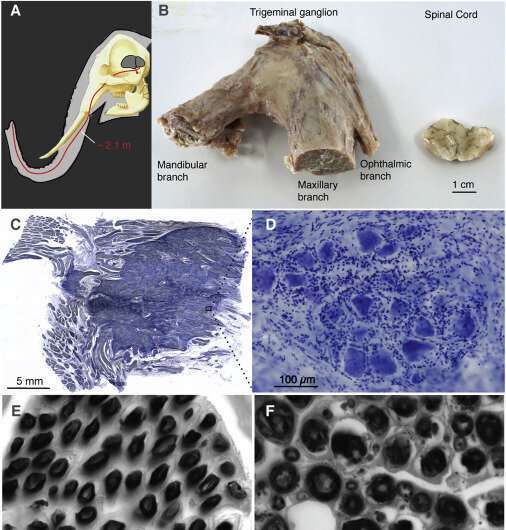January 21, 2022 report
The nerve bundle in an elephant's trunk found to be one of the largest known structures of its type

Bob Yirka
news contributor

A team of researchers working at the Bernstein Center for Computational Neuroscience in Berlin, has found that the nerve bundle in an elephant's trunk is one of the largest known structures of its type. In their paper published in the journal Current Biology, the group describes their dissection and study of multiple elephant heads and what they learned about the nerve network in the trunk.
An elephant's trunk is agile and is used for many purposes. From sucking water from a lake, to grabbing twigs off of trees to blowing dirt over its body to stop flies from biting, the trunk is a true multi-tasking proboscis. In this new effort, the researchers have found that the trunk is also far more sensitive than has been thought.
Noting that a lot of work has been done to learn more about known sensitive animal parts, such as human fingertips, dog noses, and rodent whiskers, the team wondered about elephant trunks—a body part that has not received nearly as much study.
To learn more about the elephant trunk, the researchers obtained eight elephant heads, three Asian and five African. All had died from natural causes or were put down due to severe health problems. They note that dissecting an elephant's head is rare due to the huge size. The researchers had to first obtain special tools and machinery to conduct their work.
One of the major focus areas was the trigeminal ganglion, which is a network of nerves in the trunk and parts of the face—elephants have two of them. The team found that each weighed approximately 50 grams. They also found that each was made up of approximately 400,000 nerves, which is far more than was expected. The number was only slightly lower than for the optic nerve. They also found the main nerve in the trunk was triple the thickness of the optic nerve, which suggests that huge amounts of information are carried back and forth.
The researchers suggest their findings indicate that the elephant trunk may be one of the most sensitive body parts in the animal kingdom.
Written for you by our author —this article is the result of careful human work. We rely on readers like you to keep independent science journalism alive. If this reporting matters to you, please consider a (especially monthly). You'll get an ad-free account as a thank-you.
More information: Leopold Purkart et al, Trigeminal ganglion and sensory nerves suggest tactile specialization of elephants, Current Biology (2022).
Journal information: Current Biology
© 2022 Science X Network




















